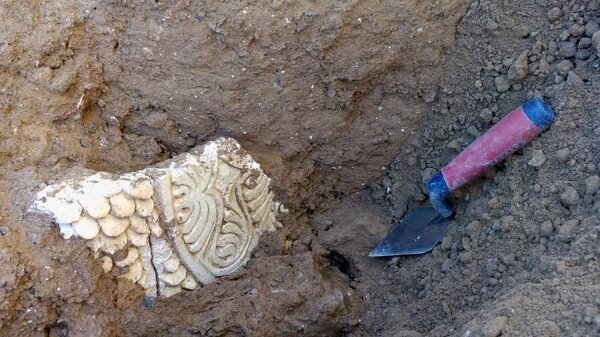Archaeologists discover Sassanid age artworks in northeast Iran

TEHRAN – Archaeologists have discovered arrays of magnificent artworks in northeast Iran, at a site that they hope will offer further clues about life during the Sassanid era (224–651).
The discoveries were made during the fifth archaeological season carried out in a valley near the village of Robat-e Sefid/Bazeh Hur in a strategic geographical point traversed by a main north-south caravan road.
According to Iranian archaeologist Meysam Labbaf-Khaniki, previous excavations brought to light the meaning of this valley, in which religious and economic aspects show and testify to the development of this region during the Sasanian and early Islamic epochs.
Archaeologists, focusing on the continuation of excavations at the site of Qala-e Dokhtar in the village, unearthed a magnificent collection of plasterwork decorated with geometric, plant, and human motifs, the Research Institute of Cultural Heritage & Tourism said.
“Recent discoveries will open a new chapter in the history of Iranian arts during the Sassanid epoch,” ILNA quoted Labbaf-Khaniki as saying on Sunday.
“This season’s excavations also revealed [other sections of] a ruined architectural complex that was a great fire temple in the Parthian and Sassanid eras… The fire temple consisted of a four-arched brick arch and a hypostyle hall,” the archaeologist explained.
The fire temple is in the form of a traditional Chahar-Taq (Chahartaq), where the four sides of the square room show an arched opening. Experts say this architectural form turned into the most typical form of Sassanid religious architecture, relating closely to the expansion and stabilization of Zoroastrianism under the Sassanid reign and continuing during the Islamic era thanks to its usage in religious and holy buildings such as mosques and tombs.
Elsewhere in his remarks, the archaeologist said each of the columns of this hall was decorated with capitals bearing exquisite stuccoworks.
“Moreover, the discovery of seals suggests administrative activities performed in this religious collection and the use of high-quality materials and decorations shows the importance of this collection to the Sassanid central government.”
Since 2014, Labbaf-Khaniki has conducted several surveys at the ancient site to study the Sassanid monument itself, carrying out the plan of the original building and identifying further structures around it.
In 2018, a joint Franco-Iranian mission decided to study the whole valley, its human occupations, its geomorphology, its implication in the large territory of Khorasan Razavi province, as well as the monuments surrounding the Chahar-Taq.
The Sassanid era is of very high importance in the history of Iran. Under Sassanids, Persian architecture and arts experienced a general renaissance. Architecture often took grandiose proportions such as palaces at Ctesiphon, Firuzabad, and Sarvestan which are amongst the highlights of the ensemble.
Generally, a Sassanid archaeological landscape represents a highly efficient system of land use and strategic utilization of natural topography in the creation of the earliest cultural centers of the Sassanid civilization.
In 2018, an ensemble of Sassanian historical cities in southern Iran, titled “Sassanid Archaeological Landscape of Fars Region”, was named a UNESCO site. The ensemble is comprised of eight archaeological sites situated in three geographical parts of Firuzabad, Bishapur, and Sarvestan.
The World Heritage reflects the optimized utilization of natural topography and bears witness to the influence of Achaemenid and Parthian cultural traditions and of Roman art, which later had a significant impact on the architecture and artistic styles of the Islamic era.
Apart from architecture, crafts such as metalwork and gem-engraving grew highly sophisticated, yet scholarship was encouraged by the state. In those years, works from both the East and West were translated into Pahlavi, the language of the Sassanians.
AFM
